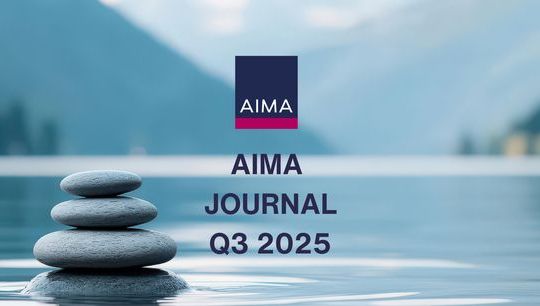AIMA's Head of Research discusses 'The truth about hedge fund performance'
By Tom Kehoe, Global Head of Research, AIMA
Published: 04 June 2018

- Comparing hedge funds to equities made sense at one point, but not any longer.
- What investors truly care about is how hedge funds compare on a risk-adjusted basis.
- On a risk adjusted performance, hedge funds have out-performed equities and bonds on a one, three, five, and ten-year period.
- Investors far prefer steadier returns with lower volatility than high level of returns with excessive volatility.
- The better way to evaluate the role of hedge funds is as a risk management tool for the wider investor portfolio. Allocating to hedge funds allows the investor to meet individual and more customised asset-liability management objectives in terms of risk-adjusted returns, diversification, lower correlations, lower volatility and downside protection.
- The inclusion of hedge funds in an investor’s portfolio comprised of bonds, equities and other asset classes can provide a more controlled risk profile and help to reduce its overall volatility. Further, such a portfolio can beat the traditional (60/40) balanced investment portfolio.
It’s a phenomenon that seems as certain and as regular as the sunrise that the hedge fund industry is once again back in the crosshairs. The latest volley comes from the Toronto based CEM Benchmarking (CEM), a provider of investment cost and performance benchmarking for large institutional investors including pension funds.
In our role as the representative of the global hedge fund industry, we welcome and encourage debate of all types regarding hedge funds. Respectfully, to the uninitiated, the CEM piece is a compelling read, and we too also feel compelled to react to it, to address the many misperceptions contained within the advice provided. We would like to thank the members of AIMA’s research committee [1] in helping us to provide this piece.
The authors of the CEM piece set the tone at the beginning of their paper by declaring that most hedge fund portfolios “have unattractive returns and no risk reducing characteristics”. A bold statement if ever there was one. It is also without foundation.
We would argue that risk and return cannot be separated when properly evaluating hedge funds. To borrow a famous phrase from Warren Buffett, “the two golden rules of investing are number one – don’t lose money and rule number two – don’t forget rule number one!” Investors look for something similar in their hedge fund investments, to protect them from the Achilles heel of deep losses, reduce the daily volatility of equity and bond markets, and bring much-needed diversification to their portfolios.
What investors truly care about is how hedge funds compare on a risk-adjusted basis – a way of measuring the value of the returns delivered in terms of the risk taken on an investment. The most sophisticated investors far prefer steadier returns with lower volatility than higher ones with greater volatility, because of the risk of potential loss that higher volatility brings. Hedge funds deliver risk-adjusted performance that provides investors with diversification benefits, even during the most difficult macro-economic environments. Institutional investors continue to allocate to hedge funds because of the proven logic that a broadly diversified allocation still holds over time.
Earlier this year, in conjunction with Preqin, we analysed the returns of more than 2,000 hedge funds that report to Preqin’s All Strategies hedge fund index, (an equal weighted hedge fund industry benchmark). We concluded that hedge funds have produced more consistent and steadier returns than equities or bonds over the short and long term. On a risk-adjusted basis, they have out-performed equities and bonds over a one, three, five and ten-year period. [2]
CEM highlight 2008 as being a prime example where “hedge funds did not provide investors with protection during extreme market turmoil”. Respectfully, we beg to differ. Revisiting the events of 2008, which was arguably the ultimate testing ground for hedge funds, the average hedge fund portfolio fell in value by 20%. That was painful, but far less than the 50% drop in equities. And the recovery, for the average hedge fund, was swift having regained its high-water mark (or to put another way, recovered from its 2008 losses) by October 2010, compared to global equities which remained under water until nearly three years beyond that.
That aside, comparing hedge fund performance to the performance of equities made sense at one point, but no longer. [3] To what extent are such comparisons realistic? Are they a like for like comparison or are we comparing apples and oranges. The hedge fund sector today is now more diverse and more global. A prime example of this is that investors in hedge funds have a choice of at least 20 different investment strategies [4] to choose from.
The better way to evaluate the role of hedge funds for investors is how they perform as part of a more diverse investor portfolio which includes equity, bonds and other asset classes. As per analysis conducted in a research paper [5] that we conducted with AIMA’s Investor Steering Committee [6] and CAIA, the inclusion of hedge funds in an investor’s portfolio comprising of bonds, equities and other asset classes can provide a more controlled risk profile and help to reduce its overall volatility. The paper goes on to demonstrate that investors who allocate to hedge funds on this basis as part of a more diverse portfolio will beat the 60/40 balanced portfolio approach to investing when measured on a risk-adjusted basis.
The memory of the global financial crisis may be fading for some, particularly after the rising tide of equity markets since then, and the meagre volatility that markets have shown during that period. What a shame it would be if the lesson of 2008 is unlearned just in time for the next downturn.
CEM also criticises how hedge funds benchmark themselves to cash-based and specialty-hedge fund indices when reporting their performance. Instead, they put forward their own ‘investable’ benchmarks, yet there is no explanation as to how they constructed them. Upon closer analysis, the author appears to be solving for these benchmarks ex-post for the mix of equity/debt exposure that results in the highest possible correlation for the hedge fund portfolio.
This would incorrectly assume that investors would have been able to select the correct blend of equity/debt allocations ex-ante to replicate the return stream of their HF portfolio. Put simply, this is a hypothetical approach, where the process seems to adjust cash and equity/debt weights considering backward-looking volatility and correlations, two of the most important factors in determining hedge fund performance. On that basis, we would question whether the benchmarks are truly investable, as per CEM’s suggestion.
CEM explains that their custom benchmarks to measure hedge fund performance are specifically designed to have a beta of 1. Perhaps a point lost on them is that most hedge fund portfolios are designed to have a beta of less than 1. Put more simply, investors allocate to hedge funds given their ability to diversify away from public markets. Indeed, the very best hedge fund managers do not align themselves to any benchmark.
We query the sample size of global funds that CEM surveys to produce its findings for this paper. As mentioned in their piece, “results for the paper are based on a one-time survey completed by 27 leading global funds and CEM hedge fund data from 382 funds”. By comparison, analysis carried out by the industry providers Preqin find an estimated 1,400 pension funds globally that allocate to hedge funds. The authors sample does not represent the average investor and its size cannot render statistically significant results. To extrapolate any meaningful trends regarding an investment plan’s experience of allocating to a hedge fund from this analysis is questionable, to say the least.
We also query how CEM arrives at its conclusion that “high costs are the main reason why hedge funds performed poorly.” They do not disclose the constituents that make up the cost analysis that they present. In the interests of fairness and to help investors truly understand how they arrive at this conclusion, a more detailed breakdown regarding the cost analysis is required.
What is indisputable is that management fees being charged by hedge funds are being challenged. Where once a 2% management fee was considered the norm for the industry, nowadays it’s likely to be closer to 1.6%. [7] Some hedge funds operate on management fees even lower than that. Further, managers and investors continue to find ways to align their interests more closely to each other so that fees are structured in a way that allows for a fair and equitable split between them both. [8]
Encouragingly, CEM point to hedge fund use increasing across their global database “from 2.1% in 2000 to 52.7% in 2016, and those that have an allocation to hedge funds “have increased their allocation from 5.8% in 2000 to 7.7% in 2016”. On this point, we are in total agreement.
A measure of the continued attractiveness of the hedge fund industry to investors is demonstrated by the continued capital investment into the industry. Over the past 12 months, over $70 billion of capital investment has been allocated to hedge funds. Further, preliminary indications for 2018 point to a further $20 billion net inflow received by the industry.
A further sign of the increased appetite for hedge funds is the return of the mega hedge fund launch. Over the coming month, the industry will welcome the largest hedge fund launch ever. This news comes amid a spate of mega hedge fund launches slated for the second half of this year. It begs us then to ask the question, if hedge funds really are so disappointing as CEM suggests them to be, then why the continued interest in them from some of the most sophisticated institutional investors across the globe?
In addressing these questions and others, we have an array of educational papers which we make available not just to our members but to the public also. In providing this service, we draw upon the expertise and diversity of our members to provide leadership in hedge fund industry initiatives such as advocacy, policy, educational programmes and sound practice guidance.
In recent years, discussions continue to persist about the value of hedge funds for investors. With these in mind, together with the Chartered Alternative Investment Analyst Association (CAIA), the global leader in alternative investment education we launched a series of papers aimed to help trustees and other fiduciaries better understand and manage hedge funds. These and other investor-led guides can be found here. Please do take a moment to read these, and we would be grateful for your feedback.
Footnotes
[1] AIMA’s research committee produces manager driven primary research and through leadership on all aspects of the hedge fund business model. Membership of this global committee comprises of hedge fund managers, asset managers, fund service providers and representatives from the hedge fund academic community.
[3] For further discussion on this and how better to understand hedge fund performance, please see “Apples and Apples: How to understand hedge fund performance” https://www.aima.org/uploads/assets/uploaded/ec2abc81-c16d-4b67-8465dc67308a7892.pdf
[4] For further discussion on this and how better to understand hedge fund performance, please see “Apples and Apples: How to understand hedge fund performance” https://www.aima.org/uploads/assets/uploaded/ec2abc81-c16d-4b67-8465dc67308a7892.pdf
[5] "Portfolio Transformers – Examining the role of hedge funds as substitutes and diversifiers in investor portfolios" https://www.aima.org/uploads/assets/uploaded/202d1073-fb04-49e3-b4121ff936c29ef4.pdf
[6] Membership of this global committee comprises of institutional investors who allocate to hedge funds. They include, state pension plans, sovereign wealth funds, endowment and foundations, fund of funds, insurers, private wealth platforms, and family offices. The committee undertakes educational initiatives, including producing and endorsing investor-related education, and industry thought leadership to demonstrate the role that alternative investments offer in the investor portfolio.
[7] http://docs.preqin.com/newsletters/hf/Preqin-Hedge-Fund-Spotlight-May-2018.pdf
[8] To read more on how hedge funds and their investors are aligning their interests better, please see AIMA’s “In Concert” paper at https://www.aima.org/uploads/assets/uploaded/df23fb37-78ff-4d57-88859a7d70167d02.pdf







